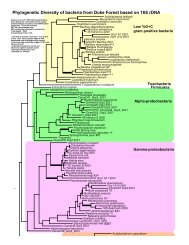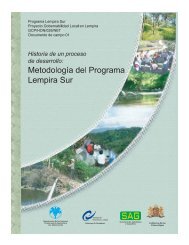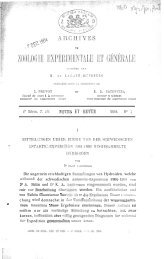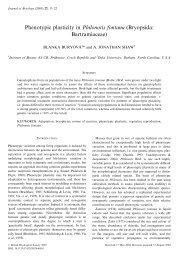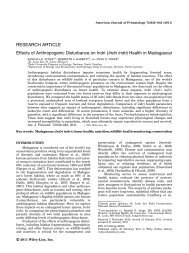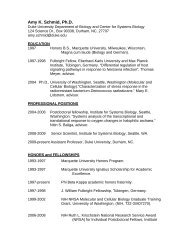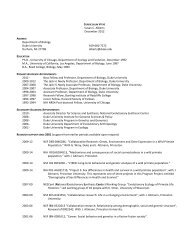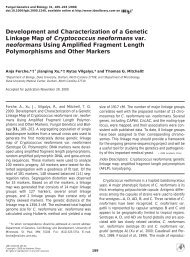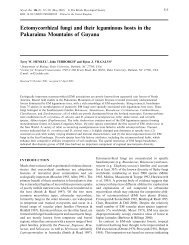Rapid evolution of a polyphenic threshold - Duke Biology - Duke ...
Rapid evolution of a polyphenic threshold - Duke Biology - Duke ...
Rapid evolution of a polyphenic threshold - Duke Biology - Duke ...
Create successful ePaper yourself
Turn your PDF publications into a flip-book with our unique Google optimized e-Paper software.
Moczek and Nijhout <strong>Rapid</strong> <strong>evolution</strong> <strong>of</strong> a <strong>polyphenic</strong> <strong>threshold</strong> 267<br />
in sneaking rather than fighting and should therefore remain<br />
hornless. Such a selection environment would favor genotypes<br />
that match the developmental switch from no to complete<br />
horn expression to a body size that corresponds to the<br />
point <strong>of</strong> equal fitness between fighting and sneaking tactics<br />
(Moczek et al. 2002; for a general derivation <strong>of</strong> this model, see<br />
Hazel et al. 1990; Gross 1996). However, the optimal body<br />
size at which to switch from sneaking to fighting behaviors<br />
may vary as a function <strong>of</strong> external conditions (Gross 1996).<br />
For example, because fights are energetically costly, an increase<br />
in the local density <strong>of</strong> competing males, with a corresponding<br />
increase in the frequency <strong>of</strong> male–male encounters,<br />
may allow only but the very largest and strongest males to<br />
benefit from engaging in fights. Under high density conditions,<br />
sneaking behavior may thus become pr<strong>of</strong>itable over a<br />
wider range <strong>of</strong> body sizes, which in turn would favor a corresponding<br />
shift <strong>of</strong> the <strong>threshold</strong> for horn production to larger<br />
body sizes (Moczek 2002b, Moczek 2003). Fitness estimates<br />
<strong>of</strong> both male morphs under a range <strong>of</strong> environmental conditions<br />
are clearly needed to test such hypotheses. We are currently<br />
exploring whether allometrically divergent populations<br />
indeed exhibit consistent differences in demographic factors<br />
and the extent to which such factors have the power to result<br />
in selection on body size <strong>threshold</strong>s in onthophagine beetles.<br />
Acknowledgments<br />
We are indebted to T. Weir for his much appreciated support and advice<br />
throughout the course <strong>of</strong> this study and to J. Hunt for collecting<br />
O. taurus in Western Australia. Special thanks go to D. Higdon and<br />
the <strong>Duke</strong> University Statistical Consulting Center for developing the<br />
likelihood analysis and for expert advice on the statistical analysis <strong>of</strong><br />
allometries. F. T. Krell confirmed species identity for all our samples<br />
and ensured that North Carolinian and Western Australian O. taurus<br />
populations were free <strong>of</strong> O. illyricus. T. Weir, J. Ridsdill-Smith, R.<br />
Staals, P. E. Skelley, and E. Barbero helped to make museum material<br />
available to us. We thank the following institutions for providing<br />
specimen loans: the Australian National Insect Collection, CSIRO,<br />
Canberra, Australia; the Museo Nacional de Ciencias Naturales,<br />
Madrid, Spain; the South Africa National Collection <strong>of</strong> Insects, Pretoria,<br />
South Africa; and the Universita di Turino, Italy. We thank J.<br />
Hunt, J. Feehan, J. Ridsdill-Smith, S. Shattuck, L. W. Simmons, and<br />
J. Tomkins for logistic support and J. Mercer and the <strong>Duke</strong> Morphometrics<br />
Laboratory for access to equipment. We thank S. Richards for<br />
his excellent drawings <strong>of</strong> O. taurus, and C. Patel for her assistance in<br />
locating taxonomic literature on O. illyricus. A. P. M. was funded by<br />
the Department <strong>of</strong> Zoology and <strong>Biology</strong>, <strong>Duke</strong> University, a National<br />
Science Foundation Dissertation Improvement Grant IBN 9972567,<br />
a Sally Hughes-Schrader International Fellowship, a <strong>Duke</strong> University<br />
Grant for International Studies, a Robert R. Bryden/North Carolina<br />
Academy <strong>of</strong> Science Fellowship, a Sigma Xi Grant-in-Aid <strong>of</strong><br />
Research, and a Katheryn Stern Fellowship. H. F. N. was funded in<br />
part by NSF grant IBN 9728727.<br />
REFERENCES<br />
Ahlroth, P., Alatalo, R. V., Hyvärinen. E., and Suhonen, J. 1999. Geographical<br />
variation in wing polymorphism in the water strider Aquarius<br />
najas (Heteroptera: Gerridae). J. Evol. Biol. 12: 156–160.<br />
Australian Meat Research Committee (AMRC) Workshop Report. 1982.<br />
The Biological Control <strong>of</strong> Dung in Australia. Commonwealth Scientific<br />
Research Organization, Canberra.<br />
Balthasar, V. 1963. Monographie der Scarabaeidae und Aphodiidae der<br />
palaearktischen und orientalischen Region (Coleoptera: Lamellicornia).<br />
Band 2, Coprinae. Verlag der tschechoslowakischen Akademie der<br />
Wissenschaften. Prag.<br />
Baraud, J. 1992. Coléoptères scarabaeiodea d’Europe. Fédéracion<br />
Française des Sociétiés des Sciences Naturelles, Paris.<br />
Davis, L. V. 1958. The Scarabaeidae <strong>of</strong> Durham and Orange Counties,<br />
North Carolina. MS thesis, <strong>Duke</strong> University, North Carolina.<br />
Denno, R. F., Douglass, L. W., and Jacobs, D. 1986. Effects <strong>of</strong> crowding<br />
and host plant nutrition on a wing-dimorphic planthopper. Ecology 67:<br />
116–123.<br />
Denno, R. F., Roderick, G., Peterson, M. A., Huberty, A. F., Döbel, H. G.,<br />
Eubanks, M. D., Losey J. E., and Langellotto, G. A. 1996. Habitat persistence<br />
underlies intraspecific variation in the dispersal strategies <strong>of</strong><br />
planthoppers. Ecol. Monogr. 66: 389–408.<br />
Edwards, A. W. F. 1972. Likelihood. Cambridge University Press. Cambridge,<br />
UK.<br />
Emlen, D. J. 1994. Environmental control <strong>of</strong> horn length dimorphism in<br />
the beetle Onthophagus acuminatus (Coleoptera: Scarabaeidae). Proc.<br />
R. Soc. Lond. B 256: 131–136.<br />
Emlen, D. J. 1996. Artificial selection on horn length-body size allometry<br />
in the horned beetle Onthophagus acuminatus (Coleoptera: Scarabaeidae).<br />
Evolution 50: 1219–1230.<br />
Emlen, D. J. 1997. Alternative reproductive tactics and male-dimorphism<br />
in the horned beetle Onthophagus acuminatus (Coleoptera: Scarabaeidae).<br />
Behav. Ecol. Sociobiol. 41: 335–341.<br />
Emlen, D. J. 2000. Integrating development with <strong>evolution</strong>: a case study<br />
with beetle horns. Bioscience 50: 403–418.<br />
Emlen, D. J., and Nijhout, H. F. 1999. Hormonal control <strong>of</strong> male horn<br />
length dimophism in the dung beetle Onthophagus taurus (Coleoptera:<br />
Scarabaeidae). J. Ins. Physiol. 45: 45–53.<br />
Emlen, D. J., and Nijhout, H. F. 2000. The development and <strong>evolution</strong> <strong>of</strong><br />
exaggerated morphologies in insects. Annu. Rev. Entomol. 45: 661–708.<br />
Fincher, G. T., and Woodruff, R. E. 1975. A European dung beetle, Onthophagus<br />
taurus Schreber, new to the U.S. (Coleoptera: Scarabaeidae).<br />
Coleopt. Bull. 29: 349–350.<br />
Gross, M. R. 1996. Alternative reproductive strategies and tactics: diversity<br />
within sexes. Trends Ecol. Evol. 11: 92–98.<br />
Gross, M. R., and Repka, J. 1998. Stability with inheritance in the conditional<br />
strategy. J. Theor. Biol. 192: 445–453.<br />
Harrison, R. G. 1979. Flight polymorphism in the field cricket Gryllus<br />
pennsylvanicus. Oecologia 40: 125–132.<br />
Hazel, W. N., and Smock, R. 1993. Modeling selection on conditional strategies<br />
in stochastic environments. In J. Yoshimura, and C. W. Clark<br />
(eds.). Adaptation in Stochastic Environments. Springer-Verlag, Berlin,<br />
pp. 147–154.<br />
Hazel, W. N., and West, D. A. 1982. Pupal colour dimorphism in swallowtail<br />
butterflies as a <strong>threshold</strong> trait: selection in Eurytides marcellus<br />
(Cramer). Heredity 49: 295–301.<br />
Hazel, W. N., Smock, R., and Johnson, M. D. 1990. A polygenic model for<br />
the <strong>evolution</strong> and maintenance <strong>of</strong> conditional strategies. Proc. R. Soc.<br />
Lond. B 242: 181–187.<br />
Hazel, W. N., Ante, S., and Stringfellow B. 1998. The <strong>evolution</strong> <strong>of</strong> environmentally-cued<br />
pupal colour in swallowtail butterflies: natural selection<br />
for pupation site and pupal colour. Ecol. Entomol. 23: 41–44.<br />
Hoebeke, R. E., and Beucke K. 1997. Adventive Onthophagus (Coleoptera:<br />
Scarabaeidae) in North America: geographic ranges, diagnoses,<br />
and new distributional records. Entomol. News 108: 345–362.<br />
Hunt, J., and Simmons, L. W. 1997. Patterns <strong>of</strong> fluctuating asymmetry in<br />
beetle horns: an experimental examination <strong>of</strong> the honest signalling hypothesis.<br />
Behav. Ecol. Sociobiol. 41: 109–114.<br />
Hunt, J., and Simmons, L. W. 1998. Patterns <strong>of</strong> parental provisioning covary<br />
with male morphology in a horned beetle (Onthophagus taurus)<br />
(Coleoptera: Scarabaeidae). Behav. Ecol. Sociobiol. 42: 447–451.<br />
Kingsolver, J. G. 1995. Fitness consequences <strong>of</strong> seasonal polyphenism in<br />
western white butterflies. Evolution 49: 942–954.<br />
Lively, C. M. 1986a. Predator-induced shell dimorphism in the acorn barnacle<br />
Chtamalus anisopoma. Evolution 40: 232–242.




